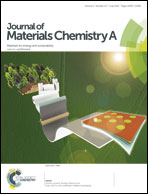CuInS2/ZnS nanocrystals as sensitisers for NiO photocathodes†
Abstract
Nickel oxide (NiO) is the most universally studied photocathode to date, however, its poor fill factor (FF) makes its efficiency much lower than its counterpart, n-type photoanodes. Its significance in photovoltaics is based on the potential to fabricate tandem photoelectrodes in order to enhance the overall efficiency of the existing devices. Furthermore, limited work on the sensitisation of NiO with semiconducting nanocrystals (NCs) exists. For the first time, we have fabricated NiO photocathodes sensitised with aqueous CuInS2/ZnS NCs. The NCs were chemically bound to the NiO films with the aid of carboxyl and thiol groups. This was achieved without modifying the bulk surface properties of NiO. Binding of the NCs was investigated using TEM, SEM, XPS, XANES, EXAFS modelling and ToF-SIMS. NiO films were assembled into CuInS2/ZnS NC sensitised photocathodes and their photovoltaic properties were compared to those of unsensitised and dye-sensitised NiO solar cells. We demonstrate that non-toxic NCs can be used to sensitise NiO photocathodes to achieve an (almost) all-inorganic system.


 Please wait while we load your content...
Please wait while we load your content...